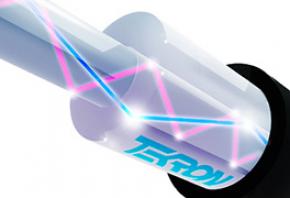Types of Fiber and Copper Cabling
Fiber is a short term for fiber optic cabling, which is based on glass or plastic fibers.
Smaller than a strand of hair, the fibers can transmit a lot of data very quickly. The information is transmitted by first encoding the data into pulses of light. At the other end a photoelectric cell converts the pulses of light back into electrical information.
There are two main types of fiber cabling: single-mode and multi-mode. These have different properties that make them suited to different applications. The term "mode" refers to a ray of light at a particular angle. In both cases the cable consists of several layers, but the main two are the "core" and the "cladding". The core contains the actual light signals, while the cladding is also glass or plastic but has a lower refractive index, creating a mirror which keeps the light inside the core.
Being made of glass, one downside is that the cables are very brittle and can't be bent sharply. Shattered glass fibers don't transmit data well. This is balanced however by the fact that it is light being transmitted and not electrical current, so there is no interference from outside factors such as radio frequencies and electromagnetic noise.
Single-mode
Single-mode is a single thin strand of glass about 9 microns thick. A "mode" refers to the angle at which light enters the fiber, with straighter angles which will bounce around inside the cable less being better. Single-mode only has enough room for one, and it's kept exactly straight to minimize bounce. This type excels at high data rates and long distances, but as narrower light waves are used (for the narrower glass) specialized light emitters are needed which can be more costly than standard solutions. The advantages of single-mode, however, are that it can transmit further than multi-mode by up to 50 times due to the reduced number of bounces and less internal signal scattering. The single strand of glass also eliminates distortion from other waves, further increasing the speed and accuracy of transmission.
Single-mode fiber can be used in many applications. Currently, it's main use is in telecom networks and cable television, where long distances and high bandwidth are required.

Multi-mode
Multi-mode fiber is a cheaper type of fiber cable. It has a much thicker core, allowing more than one mode (or signal) to be sent at once. This does, however, result in a degrading signal over distance - but not enough to be an issue in substations or other single-site applications.
Multi-mode fiber works by sending out multiple light bursts at different entry angles. The downside is that because lots of bursts of light are being transmitted along the same length of cable, interference and scattering effects degrade the signal quality over distance. Also, the different angles of different modes lead to different travel times, degrading performance.
Typically however this isn't a problem over distances less than a couple of kilometers. That's why it's used in data centers and substations, or other applications where short distances and large amounts of cable are required.
As a rule, Tekron clocks only support multi-mode due to this being the best and most popular choice in local timing networks, especially in substations where fiber mitigates the effects of electrical noise.
Copper
Copper is the most common form of cabling for networking. It's rated highly for conductivity and as such can conduct electricity more easily than other metals.
It's much cheaper than fiber, however, it's much slower in terms of data rates. If speed is of the essence, fiber is better for the same thickness of cable.
Being metal, interference can be an issue. Radio bursts and electromagnetic noise can degrade signal quality to the point of being unusable depending on the environment, and there's also the potential for wiretapping, unlike fiber.
Being an older standard, copper has the benefit of excellent interoperability and legacy compatibility.
Coaxial
An in-between option in terms of cost and performance, Coaxial or Coax is much like copper, where an electrical current transmits data. Coax has 3 main components to its cable. The first is the core, made of copper or another conductive material. This aspect works exactly as a copper wire would by sending electric pulses to encode a message. The next layer is an insulation layer to keep things contained, as well as keeping data safe from physical damage to the cable. Lastly is a shield, also made of copper. The shield doesn’t intentionally conduct current but is used to help absorb any external interference that may affect the transmitting of data. This is why we often see Coax next to antennas or transmission lines in cases where fiber may be too expensive or overrated.


